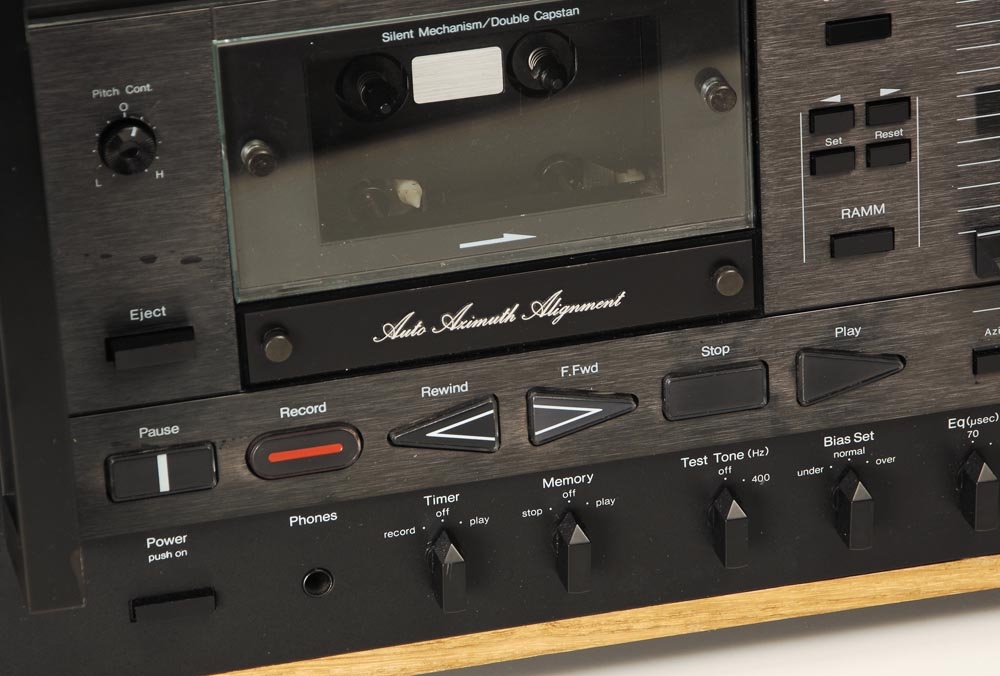

ModelsĪ few popular Nakamichi cassette deck models were (and some still are):ĭragon RX-202 RX-505 BX 125e Nakamichi Cassette Decks value and price guide Also offered was a third more affordable deck: the 700ZXE auto tuning tape deck. Hence the 1000ZXL and 700ZXL were known as 'computing cassette decks'. With this function, the user could optimize the deck to a specific brand of cassette to get best recording results from every tape. Payed 15 years ago about 1600 guilders, today it does about 800 guilders.

for Azimuth, Bias, Level, and Equalization. The LX-3 is one of the rare 2-head tapedeck with a dual-capstan mechanisme.This deck has the same high-quality tape-transport as the more expensive ZX-line form Nakamichi. Stephen Sank owns that site and is THE nakamichi tapedeck guru for upgrades/service. They also had built-in computers for calibrating the decks to a specific tape. My first choice would be the ZX9 every time.

#Nakamichi tapedeck full
The 1000ZXL and 700ZXL had full metal capability as well as normal and high bias abilities. In 1980, Nakamichi introduced the third gen of 1000 and 700 three-head tape decks. The tape type settings on these decks were ZX (metal bias), EX (normal bias), and SX (high bias). When metal bias IEC TYPE IV tapes hit the market in 1978, Nakamichi made some early metal tape capable decks such as the 580M. Nakamichi also sold its own brand of blank audio tapes. The settings for the normal and high bias were labeled as EX and SX respectively. Competitor decks offered Ferri Chrome (IEC TYPE III) whereas Nakamichi chose not to do so. These lines had tape bias settings for normal bias (IEC TYPE I) and high bias (IEC TYPE II). The first three-head decks were the models 1000 and 700, introduced in 1973. The three-head mechanism allowed higher quality reproduction as well as the ability to hear a recording in progress - as the tape traveled past the recording head onto the playback head. Previously the playback and recording functions were combined in a single tape head. Separate tape heads were used for playback, recording, and erase. They were the first to use a three-head recording technique in a cassette deck. Since then, it has established itself as a trusted creator of high-quality audio products, such as the Nakamichi 1000, the world's first 3-Head cassette deck. Etsuro Nakamichi, starting from a small research institute in Tokyo, Japan that provided R&D for major brands, government entities, universities and organizations. This kit includes everything needed to replace all existing. Nakamichi 1000 Tri Tracer, Nakamichi 1000II Tri Tracer, Nakamichi 1000ZXL, Nakamichi 1000ZXL Limited, Nakamichi 250, Nakamichi 350, Nakamichi 480, Nakamichi 480Z, Nakamichi 481, Nakamichi 481Z, Nakamichi 482, Nakamichi 482Z, Nakamichi 500, Nakamichi 550 Dual Tracer, Nakamichi 580, Nakamichi 580M, Nakamichi 581, Nakamichi 581Z, Nakamichi 582, Nakamichi 582Z, Nakamichi 600, Nakamichi 600II, Nakamichi 660ZX, Nakamichi 670ZX, Nakamichi 680, Nakamichi 680ZX, Nakamichi 681ZX, Nakamichi 682ZX, Nakamichi 700 Tri Tracer, Nakamichi 700II, Nakamichi 700ZXE, Nakamichi 700ZXL, Nakamichi BX-1, Nakamichi BX-100, Nakamichi BX-125, Nakamichi BX-150, Nakamichi BX-2, Nakamichi BX-300, Nakamichi Cassette Deck 1, Nakamichi Cassette Deck 1.Nakamichi was founded in 1948 by Mr. Nakamichi Cr-1a Stereo 2 Head Cassette Deck Parts Part Out.


 0 kommentar(er)
0 kommentar(er)
